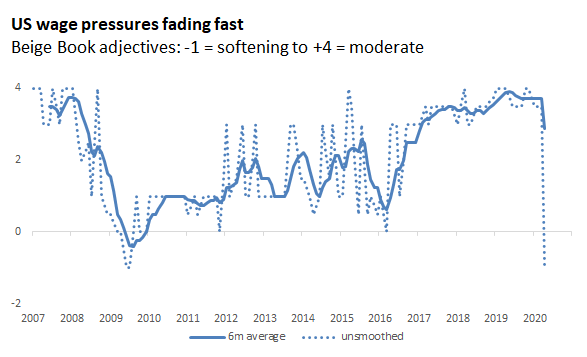Will all of this stimulus cause runaway inflation? Not so fast.
With trillions of dollars of fiscal and monetary policy support being injected to fight the coronavirus crisis, we are fielding a lot of questions from clients about the inflationary consequences of these massive government interventions.
Low inflation likely next 1-2 years
Time horizon is important here. Over the next one to two years, inflation is likely to remain very subdued, if not dangerously low. We know global labour markets have been getting hit hard in the short-term as temporary business closures from government containment efforts have led to mass layoffs. In the United States, for example, the unemployment rate now appears to be approaching 20%, based on the weekly initial jobless claims reported through last Thursday. That would mark its highest level since the Great Depression, where U.S. unemployment peaked at 25%.
This development is important, as it has completely wiped out the wage pressures that had been building over the prior expansion. The chart below is our own quantification of commentary the U.S. Federal Reserve (the Fed) collects from its local business contacts. The Fed’s latest report for April mentioned that “no district reported upward wage pressures” and that “most cited general wage softening and salary cuts.” That’s a huge change from where we were just a month ago, and it resets U.S. wage dynamics back to where they were in the depths of the 2009 recession.
Click image to enlarge

Source: Russell Investments quantification of underlying data from the Federal Reserve Board. As of April 2020.
Lower commodity prices and, in the specific case of the United States, currency strength is also likely to be disinflationary in coming months.
But what about all of the money printing?
Here, it’s useful to separate the implications of monetary policy (including quantitative easing, or QE) from fiscal policy. Starting with monetary policy, many of our readers will recall similar concerns were floated about the inflationary consequences of QE during and immediately after the financial crisis. Those concerns never materialised. If anything, developed markets struggled with the problem of inflation that was too low for too long.
Why? The answer is a bit complicated. But in short, when a central bank buys a 10-year government bond, that money shows up in the system as new bank reserves. Many of us were taught in undergraduate economics that this new money should be inflationary. The critical nuance, however, is that these reserves do not and did not flow into the real economy. U.S. banks have not been reserve constrained in over a decade. Giving them more reserves does next to nothing to their lending behaviour. At the margin, QE can help stabilise prices through positive wealth effects, and compression of risk premia, etc., but the effects on asset price inflation naturally turn out to be much larger than those on goods markets.
Fiscal stimulus and inflation
Fiscal stimulus if sustained, however, can be inflationary over the medium-term. Handing out checks to consumers (underway in the United States) or money for direct spending on highways, bridges, etc., flows more immediately into the real economy.
Thus far, most of these initiatives have only been enough to try to make impacted households and businesses whole again. Again, in a recession, that’s not particularly troubling, and is arguably the optimal policy. But will politicians get addicted to low borrowing costs and continue spending well after the current crisis has run its course? That, in our opinion, is where the real threat lies. Add to that the strategic policy reviews underway at the Fed, European Central Bank and elsewhere in which those policymakers may be willing to accept higher inflation in coming years to make up for the undershoots that will in all likelihood be realised in the months ahead.
The bottom line
There is a wide range of potential macroeconomic outcomes here, but medium-term inflation risks, in our view, do appear to be skewed to the upside. Meanwhile, inflation swaps and the inflation pricing embedded in Treasury inflation-protected securities reflect a secularly weak inflation outlook for many years to come.
Any opinion expressed is that of Russell Investments, is not a statement of fact, is subject to change and does not constitute investment advice.